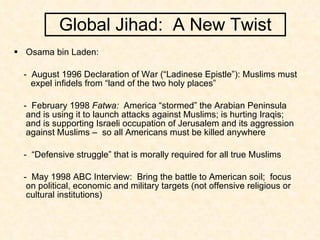The document discusses the origins and key ideologies of Islamic extremism. It outlines the conditions that promoted radicalization, such as authoritarian regimes and Western influence. It then examines influential extremist thinkers like Ibn Taymiyyah, Muhammad Ibn Abd al-Wahhab, and Sayyid Qutb, and how they reinterpreted Islam to justify violence. Finally, it traces the rise of violent jihadist groups like Al-Qaeda and their global campaigns targeting the West and other "enemies" of Islam.










![Hasan al-Banna “ Jihad is not against polytheists alone, but against all who do not embrace Islam…Today the Muslims…are compelled to humble themselves before non-Muslims, and are ruled by unbelievers…Their adversaries are in charge of their affairs, and the rites of their religion have fallen into abeyance within their own domains, to say nothing of their impotence to broadcast the summons [to embrace Islam]. Hence it has become an individual obligation, which there is no evading, on every Muslim to prepare his equipment, to make up his mind to engage in jihad, and to get ready for it…Know then that death is inevitable, and that it can only happen once. If you suffer it in the way of God, it will be your profit in this world, and your reward in the next.” “On Jihad”](https://image.slidesharecdn.com/extremeislam-111116114313-phpapp02/85/Extreme-islam-11-320.jpg)



![Sayyid Qutb “ Mankind today…is devoid of those vital values which are necessary not only for its healthy development but also for its real progress…If we look at the sources and foundations of modern ways of living, it becomes clear that the whole world is steeped in Jahiliyya (pagan ignorance of divine guidance), [which] takes the form of claiming that the right to create values, to legislate rules of collective behavior, and to choose any way of life rests with men, without regard to what God has prescribed. The result of this rebellion against the authority of God is the oppression of His creatures…” “ Western civilization is unable to present any healthy values for the guidance of mankind…Islam is the only system which possesses these values and this way of life.” Milestones , 1964](https://image.slidesharecdn.com/extremeislam-111116114313-phpapp02/85/Extreme-islam-15-320.jpg)















![Psychological Outline 1997-98: the Council on American-Islamic Relations pounded Nike into recalling 800,000 shoes because the English word "Air" in its logo allegedly resembled the Arabic lettering for "Allah." September 2005 : Response to Burger King Ad: “This is my jihad. I'm not going to rest until I find the person who is responsible. I'm going to bring this country [Britain] down."](https://image.slidesharecdn.com/extremeislam-111116114313-phpapp02/85/Extreme-islam-31-320.jpg)



![“ The Sword Verse” [9:5] And when the forbidden months have passed, slay the idolaters wherever you find them and take them captive, and beleaguer them, and lie in wait for them at every place of ambush. But if they repent and observe Prayer and pay the Zakaat, then leave their way free. Surely, Allah is Most Forgiving, Merciful.](https://image.slidesharecdn.com/extremeislam-111116114313-phpapp02/85/Extreme-islam-35-320.jpg)





